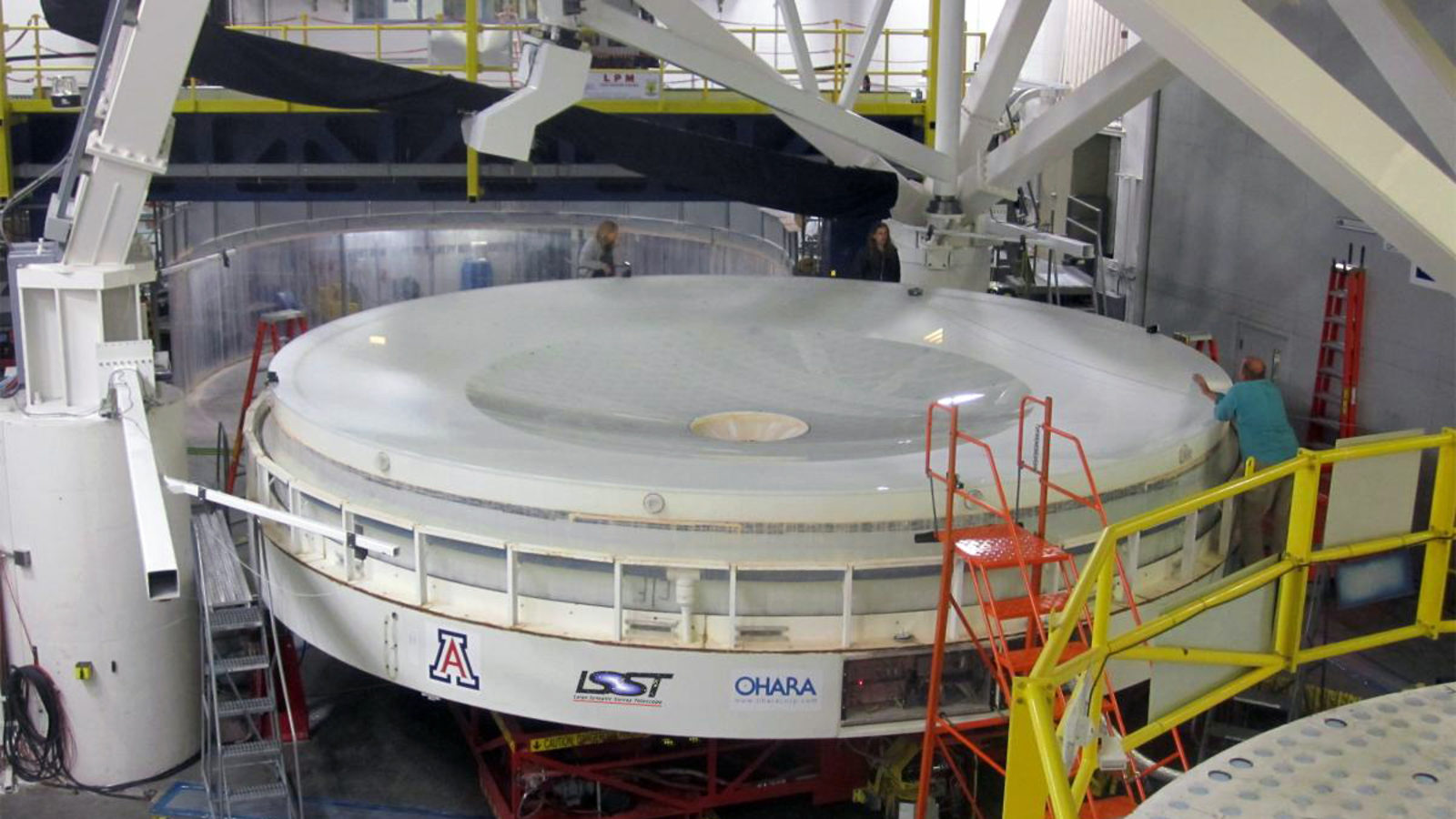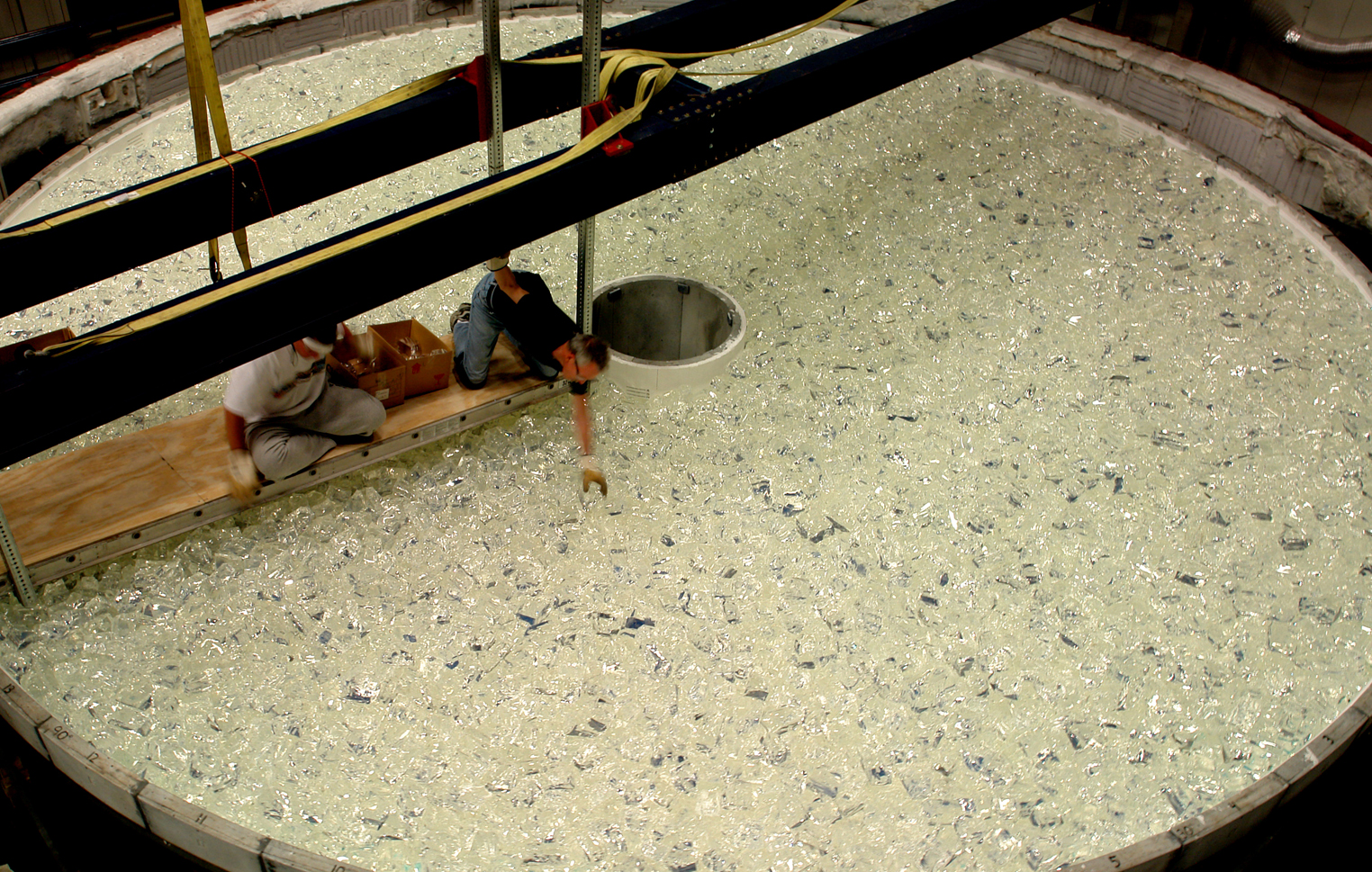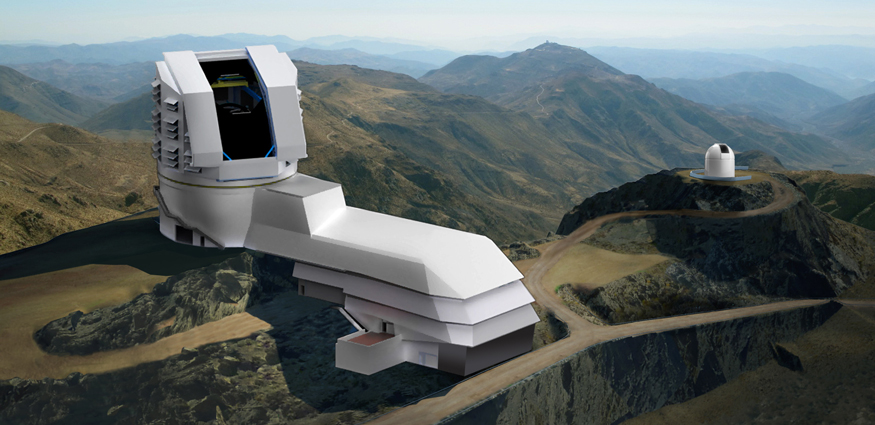In March 2008, a group of people gathered around a giant, red oven in a six-story workshop space beneath the bleachers of the University of Arizona football stadium.
The oven was about 10 meters wide and 2 meters tall, big enough to live in, really. But that day it was rendered less than hospitable by its extreme internal temperature—2200 degrees Fahrenheit—and its persistent spinning at 35 miles per hour. Also, it was full of 22 tons of molten glass.
This was the “high-fire event,” the day the glass reached its melting point, freeing it to flow into a honeycomb-patterned mold on its way to becoming one of the largest telescope mirrors in the world.
Now, after months of cooling and more than six years of grinding and polishing, the mirror is complete.
On Saturday, a new group gathered in the Steward Observatory Mirror Lab—still located under the bleachers—to admire the finished product.
It is the first completed piece of the Large Synoptic Survey Telescope, which will eventually be located on Cerro Pachón, a mountain in Chile. In 2022, the massive mirror will enable LSST scientists to begin the most thorough survey ever of the Southern sky.
Making a movie of the universe
The mirror goes by the name M1M3, and it’s actually two mirrors in one. The outer ring serves as the first mirror, M1, and another, more steeply curved mirror, M3, has been carved out of the center.
LSST will capture and focus images of the night sky by bouncing them through a series of three mirrors. Light will shine onto M1, which will reflect it up to another mirror, the 3.4-meter M2, which will reflect it down to M3, which will reflect it up into the lens of a 3.2-gigapixel camera.
The three-mirror optical system, unique among large telescopes, will allow LSST to take in nearly 10 square degrees of sky with each image—a field of view large enough to fit 40 full moons.
The combined dual-surface mirror, also unique among large telescopes, will allow scientists to align LSST just as quickly as they could a two-mirror telescope. This will help make LSST nimble enough to scan across the entire Southern sky once every three nights.
LSST’s frequent sweeps across the same areas of sky will allow scientists to monitor changes to our galaxy and others in a way that has never before been possible.
They will create time-lapse videos of asteroids, supernovae, variable stars, the effects of dark matter and dark energy—as LSST Director Steve Kahn puts it, “anything that can go bump in the night.” In the end, they hope the survey will lead to a new understanding of our universe.
The multi-year mirror
The LSST project has already met a major milestone with the completion of M1M3, although it only recently received federal funding for its construction start.
In August 2014 the National Science Foundation authorized $473 million for the project. And just this month the US Department of Energy approved $168 million for construction of the LSST camera.
The early development of LSST was supported by the LSST Corporation, a non-profit consortium of 40 universities and other research institutions. Building M1M3 and getting started on M2 have been supported by private funding: $20 million from the Charles and Lisa Simonyi Fund for Arts and Sciences; $10 million from Microsoft founder Bill Gates; and more contributions from Interface Inc. founder and chair Richard Caris; the WM Keck Foundation; Wayne Rosing and Dorothy Largay; Eric and Wendy Schmidt; and Edgar Smith.
For its part, the Tucson-based Research Corporation for Science Advancement contributed $400,000 toward the purchase of the glass.
This was no ordinary glass; it was high-quality glass made by a specialty company in Japan. It came in chunks weighing a couple of pounds each—light enough for technicians kneeling on a ramp suspended over the mold to pick them up and gently nestle them into place.
Once the mold was filled, technicians heated it in the oven, which rotated to encourage the glass to travel up the sides and form a shallow bowl shape. The honeycomb design in the mold formed 1600 air pockets in the back of the mirror to reduce its mass and increase temperature-regulating airflow.
To avoid cracking the mirror, technicians cooled it down slowly over 90 days.
Scientist Chuck Claver, who has been a part of LSST since it was no more than an interesting idea, was one of the few people in the room when the oven was finally opened.
“It’s like a cake cover,” he says. “They lift it off with a crane and then there it is… You walk up to this thing and your jaw just drops.”
Claver keeps a picture of himself and a few other scientists standing in the center of the freshly baked M1M3. “Glass is actually pretty strong stuff. You can take your shoes off and walk on it in socks,” he says.
“I hate it when they do that,” says LSST Project Manager Victor Krabbendam.
Once the baking was done, the grinding and polishing began. A special machine shaved and sanded away layers of glass—including several tons from the center to form M3—in a process that removed millimeters and then nanometers at a time.
“The shape of this mirror has to be good to small fractions of the diameter of a human hair across the whole surface,” Krabbendam says.
Soon the mirror began to take on a dull shine, like an ice-skating rink after a Zamboni polish. Today, it’s crystal clear.
After enduring a series of tests, M1M3 will go into storage in a hangar at Tucson International Airport. In a couple of years, scientists will apply a reflective surface and load it on a truck to start its journey to its mountaintop home in Chile.





